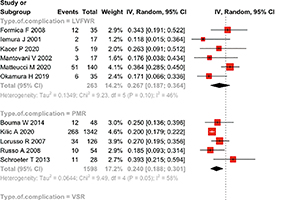Effects of concomitant coronary artery bypass grafting on early and late mortality in the treatment of post-infarction mechanical complications: a systematic review and meta-analysis
Abstract
Background: Mechanical complications of acute myocardial infarction represent life-threatening events, including ventricular septal rupture (VSR), left ventricular free-wall rupture (LVFWR) and papillary muscle rupture (PMR). In-hospital mortality is high, even when prompt surgery can be offered. The role of concomitant coronary artery bypass grafting (CABG) in the surgical treatment of these conditions is still debated.
Methods: A systematic review of the literature, from 2000 onwards, about these complications was performed, analyzing data of subjects receiving versus not-receiving concomitant CABG. Primary outcome was early mortality. Secondary outcome was late mortality for hospital survivors. Subgroup analysis for VSR, LVFWR and PMR was also performed.
Results: Thirty-six studies were identified, including 4,321 patients (mostly VSR-related). Preoperative coronarography was performed in 92.2% of the cases, showing single-vessel disease in 54.3% of patients. Concomitant CABG rate was 49.0%. Early mortality was 32.6% and late mortality was 40.0% with 5.2 years of mean follow-up. The analysis showed no difference in early (OR 0.96; P=0.60) or late mortality (RR 0.91; P=0.49) between CABG and non-CABG group. In subgroup analysis, concomitant CABG was associated with significantly lower mortality at long term for PMR (RR 0.42; P=0.001), although it showed a higher, but not significant, mortality in VSR (RR 1.24; P=0.20).
Conclusions: Concomitant CABG in the treatment for post-infarction mechanical complications showed no significant impact on both early and late mortality, although deserving some distinctions among different types of complication and single versus multiple vessel disease. However, larger, dedicated studies are required to provide more consistent data and evidence.
Cover






